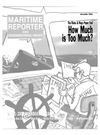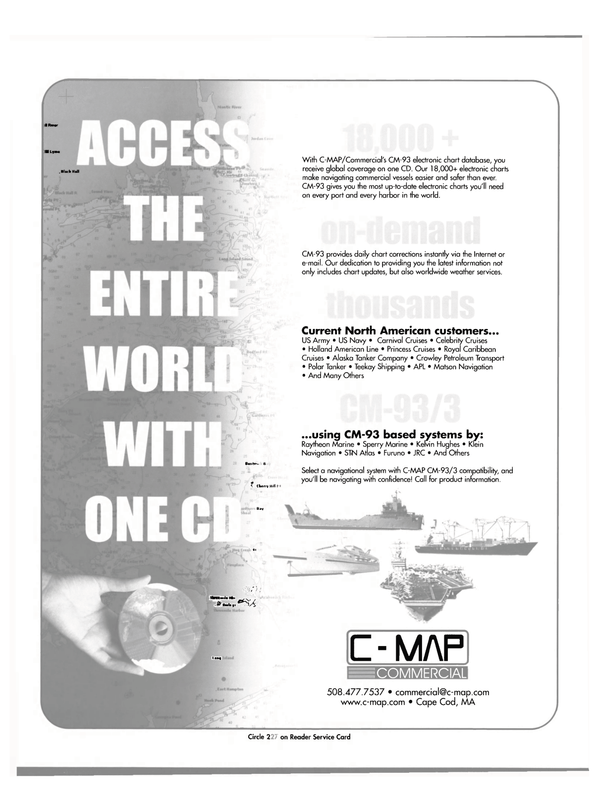
IBM PLM Offers New Shipbuilding Solutions
IBM and Dassault Systemes introduced Release 12 of their Product Lifecycle Management (PLM) solutions suite for the shipbuilding industry, featuring new applications for Structures and Compartment Design. Included in Release 12 is the latest version of CATIA Version 5, which continues to expand outfitting/machinery design and now fully integrates piping, tubing, HVAC. raceway/conduit, waveguide, electrical/instrumentation and hanger design. The latest version also provides new tools for detailing steel piece parts.
as well as the layout and detailing of entire structural systems like decks, reinforced panels, bulkheads, etc. With Release 12. IBM and Dassault Systemes deliver 21 new applications for shipbuilding.
CATIA Compartments and Access CATIA - Compartment and Access (CNA) is dedicated to the definition of compartment and access objects within a ship design. It is dedicated to defining the limits of compartment and access forms (doors, hatches, windows, portholes etc.) within a ship design. CNA provides the user with the ability to define a compartment's boundary sur- faces, to place access objects such as doors, windows and stairs into compartments, and generate unique drawings and reports. The compartment created in CNA can be used to organize downstream system design processes, set the specifications for machinery and support systems (piping, HVAC, cable trays etc.) passing through the compartment and generate unique bills of material (BOMs). Among other things, it can: • Define wall systems within a deck.
Starting with a simple sketch over the deck, wall systems are bounded by decks or molded forms. Associated with the hull surface and structural bulkheads, CNA gives the user the ability to generate multiple wall surfaces very quickly and easily their design.
• Define compartments and their boundary surfaces within a ship. Wall systems are generated in one step and the user is provided with a compartment preview before generation. When the compartments are generated, a geometric definition of the compartment is created.
The definition, in turn, can be used to generate other compartments.
Intelligent boundary objects are also automatically created for each wall surface of a compartment definition.
Compartment boundaries can be exploited in down stream production when production sub-assemblies are defined.
• Place access objects such as doors, windows, stairs within the design. This includes closure objects such as doors, windows, and hatches, as well as ladder related objects such as stairs, vertical ladders and hand grabs.
• Define Compartment used to organize downstream system design processes. Ship designers can use Compartment and Access definitions to integrate their equipments and systems and project planning.
• Provide Drawing and Report generation capabilities Where the user can define tailored view styles for compartments based on classification society, company or supplier standards. Users can also define and generate reports for compartment and access related objects.
Structural Design: Plates and Shapes CATIA - Structure Design 1 (SRI) product is an application enabling to simply and quickly create linear, curved structures, and plates, using standard or userdefined sections. The product includes a parametric catalog through design tables and it generates user customizable Bills of Materials. It is natively integrated with other CATIA applications for completing the structural design. The user will be able, for instance, to perform extensive stress analysis on his structure elements and beams. CATIA - Structure Design 1 (SRI) is a highly productive application that can create straight, curved and twisted structure, planar and surface plates, using standard or user defined sections. All members are fully associative with a user interface optimized for the placement of structures and managing piece parts. Entire assemblies made of sub-parts can be instantiation through user-defined templates. The result is a breakthrough in productivity. CATIA's infrastructure supports parametric catalogs through intelligent design tables. A wide variety of customizable Bills of Material (BOMs) are available. SRI is fully integrated with CATIA Analysis products for downsteam structural analysis. Users benefit from having one single application capable of creating of multiple types of linear, curved and twisted structures and assemblies from standard or user-defined sections. A single user interface provides simple-to-use workbench tools that can be quickly build up structural layouts by referencing existing structures (faces, edges, or vertex) near by or hull, deck or compartment features. All structural components maintain full associativity. Shipbuilders will find assembly templates a useful way to captured best practices on one project and reuse them on another. This method allows user to be extremely productive while being sure that they are compliant with their company standards and best practices.
CATIA Ship Structure Detail Design CATIA Ship Structure Detail Design (SDD). new in Release 12. extends structural design capabilities that begin with the conceptual design of the ship (hull form, general arrangement, zone and block definitions). SDD focuses on entire structural systems that are often made of composites or fabricated, assembled and erected from smaller piece parts. SDD offers highly automatic detailing functions for defining connections, penetrations, cutouts and spanning parts. Small assemblies can be defined using knowledgeware templates and then quickly instantiated thought the ship. Designers are able to assign project resources to various systems that aid later in scheduling, managing work flow, defining work packages and tracking the materials required.
SDD is fully integrated with Structure Functional Design (SFD) and able to retrieve design block information to perform the detailed design of the structure. SDD provides productive tools and an environment that manages structural systems and connections and creates physical plates and shapes.
Circle 58 on Reader Service Card
Read IBM PLM Offers New Shipbuilding Solutions in Pdf, Flash or Html5 edition of November 2003 Maritime Reporter
Other stories from November 2003 issue
Content
- EU Single-Hull Phase-Out Elicits I MO Scorn page: 10
- Costa Victoria in for a Facelift page: 11
- Sustainable Growth for Liner Shipping page: 11
- World's Biggest LNG Carrier Due in 2005 page: 12
- Shipbreaking in the Spotlight at ILO page: 14
- Signet Martime Inks Garrett Contract page: 16
- IZAR Enters Fast Ship Project page: 17
- TEN Signs Time Charter for Aframax Olympia page: 17
- Cruise Port Expenditure to Reach $300M page: 18
- At Sea with U.S. Maritime Security page: 20
- NY Navigation Channels: The Really Big Dig page: 25
- Kvichak Delivers for NY page: 28
- Vosta LMG signs U.S. contract for 18" Cutter Suction Dredge design page: 28
- Senesco Marine Christens New Drydock page: 29
- Workboat Annual 2003 • Great Boats of 2003 page: 30
- Natter Passes Command of Atlantic Fleet page: 41
- Introducing Lean Shipbuilding to U.S. Yards page: 42
- IBM PLM Offers New Shipbuilding Solutions page: 46
- Cosco Dalian Leads China Ship Repair Business page: 50
- China: Growing Influence in All Matters Maritime page: 52
- L'Orange at Marintec China 2003 page: 56
- Shiport China 2004: Set in Tune with the Shipbuilding Industry page: 57
- New Aluminum Marine Alloy Specification Developed page: 58
- InspecTech Launches Line of "Smart" Windows page: 62
- New CEO at Kvaerner Philadelphia page: 62
- Asheim Takes Helm of Hoegh Fleet page: 62
- New Potency in Electronic Control page: 68
- Research as the Building Block page: 70
- Knowledge Interchange page: 71
- Surface-Protection Symposium Set for Liibeck page: 78
- Xybernaut Gets Patent for Detecting Corrosion on Maritime Vessels page: 79
- LCS Hull Concept Tests Move Ahead page: 80
- Hypertherm Enters Laser Cutting Market page: 81
- E-Ship: The Paperless Trail page: 82
- Cradle Tweendecks Patent for Langh Ship page: 86
- Optimizing Feed Rates For Crosshead Diesels page: 88
- Benjamin Vickers: 175 Years & Counting page: 89
- Life Boats by Ernst Hatecke Make the Plunge page: 90
- Clean Seal Celebrates 25 Years page: 91
- Netherlands Vessel First With New Engine page: 92
- ONR To Evaluate SeaCoaster page: 92
- KMY Helps Breaks the Ice in Russia page: 97
- Astander Completes CSO Deep Pioneer Upgrade page: 97
- Rickmers Singapore Christened page: 97
- Transas Releases New Version of Engine Room Simulator page: 98
- Merseyside gets first UK escort tug simulator page: 98


